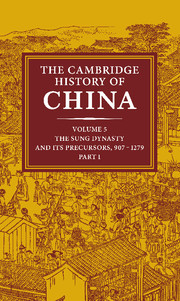Book contents
- Frontmatter
- Introduction: the Sung Dynasty and Its Precursors, 907–1279
- 1 The Five Dynasties
- 2 The Southern Kingdoms between the T’ang and the Sung, 907–979
- 3 Founding and Consolidation of the Sung Dynasty under T’ai-tsu (960–976), T’ai-tsung (976–997), and Chen-tsung (997–1022)
- 4 The Reigns of Jen-tsung (1022–1063) and Ying-tsung (1063–1067)
- 5 Shen-tsung’s Reign and the New Policies of Wang An-shih, 1067–1085
- 6 Che-tsung’s Reign (1085–1100) and the Age of Faction
- 7 The Reigns of Hui-tsung (1100–1126) and Ch’in-tsung (1126–1127) and the Fall of the Northern Sung
- 8 The Move to the South and the Reign of Kao-tsung (1127–1162)
- 9 The Reign of Hsiao-tsung (1162–1189)
- 10 The Reigns of Kuang-tsung (1189–1194) and Ning-tsung (1194–1224)
- 11 The Reign of Li-tsung (1224–1264)
- 12 The Reign of Tu-tsung (1264–1274) and His Successors to 1279
- Bibliography
- Glossary–Index
- References
8 - The Move to the South and the Reign of Kao-tsung (1127–1162)
Published online by Cambridge University Press: 28 March 2010
- Frontmatter
- Introduction: the Sung Dynasty and Its Precursors, 907–1279
- 1 The Five Dynasties
- 2 The Southern Kingdoms between the T’ang and the Sung, 907–979
- 3 Founding and Consolidation of the Sung Dynasty under T’ai-tsu (960–976), T’ai-tsung (976–997), and Chen-tsung (997–1022)
- 4 The Reigns of Jen-tsung (1022–1063) and Ying-tsung (1063–1067)
- 5 Shen-tsung’s Reign and the New Policies of Wang An-shih, 1067–1085
- 6 Che-tsung’s Reign (1085–1100) and the Age of Faction
- 7 The Reigns of Hui-tsung (1100–1126) and Ch’in-tsung (1126–1127) and the Fall of the Northern Sung
- 8 The Move to the South and the Reign of Kao-tsung (1127–1162)
- 9 The Reign of Hsiao-tsung (1162–1189)
- 10 The Reigns of Kuang-tsung (1189–1194) and Ning-tsung (1194–1224)
- 11 The Reign of Li-tsung (1224–1264)
- 12 The Reign of Tu-tsung (1264–1274) and His Successors to 1279
- Bibliography
- Glossary–Index
- References
Summary
Chao Kou (1107–87), known by his posthumous temple name as Kao-tsung (r. 1127–62), was the ninth son of Emperor Hui-tsung (r. 1100–26) and a younger brother of Emperor Ch’in-tsung (r. 1126–7). Kao-tsung was the emperor who led the restoration of the Sung dynasty and inaugurated what is known as the Southern Sung dynasty (1127–1279). Resisting the Chin dynasty’s attempts at further conquest, the Southern Sung dynasty lasted more than one hundred and fifty years and enjoyed decades of economic and cultural prosperity. In traditional Chinese historiography the Southern Sung is considered a weak dynasty, humiliated as a vassal state by the Chin (Jurchen) dynasty (1115–1234). Kao-tsung is criticized for being a weak ruler unable to avenge Sung’s humiliation at the hands of Chin and unable to recover the Sung’s former northern territory. Kao-tsung is also criticized because he and his vilified chief councilor, Ch’in Kuei (1090–1155), were responsible for the death of general Yüeh Fei (1103–41), who, because of his efforts in resisting Chin, came to be regarded as a “national hero.” Despite these criticisms, Kao-tsung is perhaps better to be remembered as the young emperor who reigned through a period of disastrous military defeats and near-terminal political crises as the Sung dynasty faced oblivion, and yet later oversaw two decades of resistance, stability, and recovery.
- Type
- Chapter
- Information
- The Cambridge History of China , pp. 644 - 709Publisher: Cambridge University PressPrint publication year: 2009
References
- 5
- Cited by



